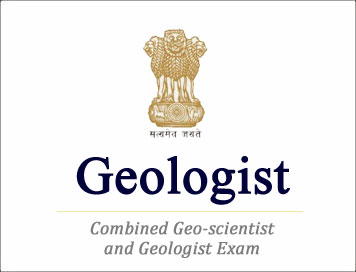(HOT) UPSC Current Affairs 2025 PDF
NEW! The Gist (OCT-2025) | E-BOOKS
UPSC Geo-Scientist and Geologist Exam Papers 2019 : Geology Paper- II

(Download) UPSC: Geologist Examination Papers-2019
Exam Name : UPSC Geo-Scientist and Geologist Exam
Subject : UPSC Geo-Scientist and Geologist Exam Papers 2019 : Geology Paper- II
Year : 2019
GEOLOGY Paper - II
Time Allowed : Three Hours
Maximum Marks : 200
Question Paper Specific Instructions
- Please read each of the following instructions carefully before attempting questions.
- There are ELEVEN questions divided under SIX Sections.
- Candidate has to attempt SIX questions in all.
- The ONLY question in Section A is compulsory.
- Out of the remaining TEN questions, the candidate has to attempt FIVE choosing ONE from each of the other Sections B, C, D, E & F.
- The number of marks carried by a question / part is indicated against it. Symbols, abbreviations and notations have their usual standard meanings.
- Attempts of questions shall be counted in sequential order.
- Unless struck off, attempt of a question shall be counted even if attempted partly. Answers must be written in ENGLISH only.
- Neat sketches are to be drawn to illustrate answers, wherever required.
- Wherever required, graphs / tables are to be drawn on the answer-book itself. Any page or portion of the page left blank in the answer-book must be clearly struck off.
SECTION-A
Write notes on each of the following: 5x10=50
1.(a) Large Ion Lithophile Element (LILE) and High Field Strength Element (HFSE)
1.(b) Carbonaceous chondrite
1.(c) Birefringence and optical retardation
1.(d) Isomorphism in minerals with examples
1.(e) Phase rule and its application in phase diagram
1.(f) Bedding and Lamination
1.(g) Source of sediments
1.(h) Metasomatism
1.(i) Ozone hole in stratosphere
1.(j) Magnitude of earthquake
SECTION—B (Mineralogy, Geochemistry and Isotope Geology)
(Attempt any ONE question)
2.(a) What are interference colours ? Why anisotropic minerals exhibit interference colours between crossed polars ? Explain with neat sketches. 10
2.(b) Discuss the structure, types, composition, physical and optical properties of mica group of minerals. 20
3.(a) Define Gibb’s free energy (G). Derive an equation showing relationship of G with Temperature (T) and Pressure (P). 10
3.(b) Discuss briefly geochemical characteristics of Rare Earth Elements (REE). Why REE abundance in a rock is expressed in chondrite normalized diagram ? What is Eu-anomaly? 10
3.(c) Derive the basic equation of radioactive dating. What is half-life (t12) ?
SECTION-C (Igneous Petrology)
(Attempt any ONE question)
4.(a) Discuss the variation in composition of basaltic magma with variation of its mantle source composition and degree of partial melting. 10
4.(b) What is Bowen's reaction principle ? State Bowen's reaction series and discuss its role in understanding magmatic differentiation. 10
4.(c) Is there any relationship between nature of magma and its tectonic setting ? Discuss with suitable examples. 10
5.(a) Describe 'perthitic' and 'granophyric texture with neat sketches. How do you explain origin of perthitic texture with the help of a suitable phase diagram? 10
5.(b) What are bases of IUGS classification of plutonic rocks and volcanic rocks? Describe with neat sketch IUGS classification of granitoid rocks. 10
5.(c) What are carbonatites and alkaline rocks? Why carbonatite is always found in association with alkaline rocks? 10
SECTION—D (Metamorphic Petrology and Processes)
(Attempt any ONE question)
6.(a) What are Barrovian zones ? What is the basis for sub-division of these zones ? 10
6.(b) Explain the concept of 'Geothermobarometry' in metamorphic rocks.
6.(c) Discuss the regional metamorphism of ultramafic rocks in terms of mineral association and P-T conditions (up to 600°C). 10
7.(a) Describe the characteristics of eclogite facies metamorphism. Add a note on types mineral assemblages of eclogite. 10
7.(b) Give a brief account on the mineral association and formation conditions of charnockites. Add a note on their occurrence in India.
7.(c) What are migmatites ? Name the types of migmatites. Discuss the petrographic components of migmatites. 10
SECTION—E (Sedimentology)
(Attempt any ONE question)
8.(a) Write names of different types of tectonic sedimentary basins. Draw a labelled diagram of sedimentary basins of India. Add note on tectonic evolution and sedimentation history of Gondwana basin of India. 20
8.(b) Describe briefly basic concept of the sequence stratigraphy.
9.(a) Describe chemical and biogenic sedimentary structures. Add a note on their origin and implications. 20
9.(b) Discuss the procedure of palaeocurrent analysis in sedimentary rocks. 10
SECTION-F (Environmental Geology and Natural Hazards)
(Attempt any ONE question)
10.(a) Discuss the impact of mineral extraction and processing in terms of water pollution. · Add note on mineral sustainability related to mining.
10.(b) Discuss the application of GI.S. in land use pattern.
11.(a) Explain various aspects of air pollution and its impact on environment.
11.(b) Briefly discuss the methods of nuclear waste disposal.
11.(c) What are the common source of groundwater pollution and contamination? 10
Click Here to Download PDF
<< Go Back To Main Page
Courtesy: UPSC

